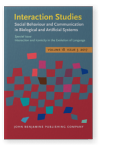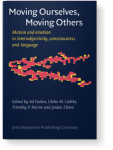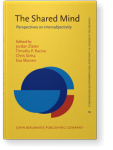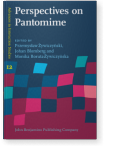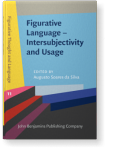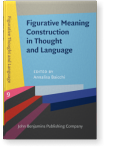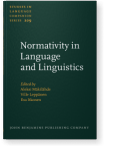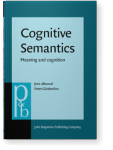Jordan Zlatev
List of John Benjamins publications for which Jordan Zlatev plays a role.
Book series
Titles
Interaction and Iconicity in the Evolution of Language
Edited by Stefan Hartmann, Michael Pleyer, James Winters and Jordan Zlatev
Special issue of Interaction Studies 18:3 (2017) v, 173 pp.
Subjects Artificial Intelligence | Cognition and language | Evolution of language | Interaction Studies
Moving Ourselves, Moving Others: Motion and emotion in intersubjectivity, consciousness and language
Edited by Ad Foolen, Ulrike M. Lüdtke, Timothy P. Racine and Jordan Zlatev
[Consciousness & Emotion Book Series, 6] 2012. viii, 492 pp.
Subjects Cognition and language | Consciousness research | Evolution of language
The Shared Mind: Perspectives on intersubjectivity
Edited by Jordan Zlatev, Timothy P. Racine, Chris Sinha and Esa Itkonen
[Converging Evidence in Language and Communication Research, 12] 2008. xiii, 391 pp.
Subjects Cognition and language | Cognitive linguistics | Cognitive psychology | Consciousness research | Evolution of language | Psycholinguistics
Articles
2024 Chapter 5. Can pantomime narrate? A cognitive semiotic approach Perspectives on Pantomime, Żywiczyński, Przemysław, Johan Blomberg and Monika Boruta-Żywiczyńska (eds.), pp. 115–138 | Chapter
Adopting the conceptual-empirical loop of cognitive semiotics, we define narrative as a three-part structure consisting of Narration, Story and Event-sequence and primary narrativity as the process of interpreting a narrative from the former to the latter two. We distinguish between simple… read more
2022 Translation validity in metaphor theories: CMT, DMT and the Motivation & Sedimentation Model Figurativity and Human Ecology, Bagasheva, Alexandra, Bozhil Hristov and Nelly Tincheva (eds.), pp. 123–148 | Chapter
Evaluating competing metaphor theories against each other implies the need for theory-independent criteria of comparison. We propose translation validity, the closeness in which theoretical constructs and operationalizations match one another, to be such a criterion. Applying this to Conceptual… read more
2021 Desiderata for metaphor theory, the Motivation & Sedimentation Model and motion-emotion metaphoremes Figurative Language – Intersubjectivity and Usage, Soares da Silva, Augusto (ed.), pp. 41–74 | Chapter
Metaphor research has increasingly diversified, leading to extensive disagreements. A set of desiderata for any contemporary theory of metaphor are (i) to account for both communication and cognition, (ii) to explain both universal and culture-specific aspects, (iii) to achieve a balance between… read more
2020 Cutting and breaking metaphors of the self and the Motivation & Sedimentation Model Figurative Meaning Construction in Thought and Language, Baicchi, Annalisa (ed.), pp. 253–282 | Chapter
Why are expressions of irreversible separation (e.g. I feel torn apart) used to speak about the self? Are they to be treated as metaphorical? We address these questions by using concepts and methods from cognitive semiotics, and especially the conceptual-empirical loop. We develop identification… read more
2019 Norms of language: What kinds and where from? Insights from phenomenology Normativity in Language and Linguistics, Mäkilähde, Aleksi, Ville Leppänen and Esa Itkonen (eds.), pp. 69–102 | Chapter
After decades dominated by a focus on the “individual speaker” and the “mind/brain” in both generative and cognitive linguistics, recent years have reinstated an older view on language as primarily social, i.e. as taking place between people more than within them. Within such a social conception of… read more
2018 R. W. Gibbs, Jr. (Ed.). (2016). Mixing Metaphor Metaphor and the Social World 8:2, pp. 326–333 | Review
2017 Interaction and iconicity in the evolution of language: Introduction to the special issue Interaction and Iconicity in the Evolution of Language, Hartmann, Stefan, Michael Pleyer, James Winters and Jordan Zlatev (eds.), pp. 303–313 | Introduction
2017 Multimodal-first or pantomime-first? Communicating events through pantomime with and without vocalization Interaction and Iconicity in the Evolution of Language, Hartmann, Stefan, Michael Pleyer, James Winters and Jordan Zlatev (eds.), pp. 465–488 | Article
A persistent controversy in language evolution research has been whether language emerged in the gestural-visual or in the vocal-auditory modality. A “dialectic” solution to this age-old debate has now been gaining ground: language was fully multimodal from the start and remains so to this day. In… read more
2012 Prologue: Bodily motion, emotion and mind science Moving Ourselves, Moving Others: Motion and emotion in intersubjectivity, consciousness and language, Foolen, Ad, Ulrike M. Lüdtke, Timothy P. Racine and Jordan Zlatev (eds.), pp. 1–26 | Article
2012 Metaphor and subjective experience: A study of motion-emotion metaphors in English, Swedish, Bulgarian, and Thai Moving Ourselves, Moving Others: Motion and emotion in intersubjectivity, consciousness and language, Foolen, Ad, Ulrike M. Lüdtke, Timothy P. Racine and Jordan Zlatev (eds.), pp. 423–450 | Article
The concepts (or “domains”) of motion and emotion are closely related in both language and experience. This is shown by the presence of many metaphorical expressions (e.g. ‘my heart dropped’) across languages denoting affective processes on the basis of expressions originally denoting physical… read more
2008 10. The co-evolution of intersubjectivity and bodily mimesis The Shared Mind: Perspectives on intersubjectivity, Zlatev, Jordan, Timothy P. Racine, Chris Sinha and Esa Itkonen (eds.), pp. 215–244 | Article
This chapter presents an evolutionary and developmental model, according to which intersubjectivity is intimately tied to bodily mimesis – the use of the body for communicative and representational purposes – to an extent that intersubjectivity can be said to co-evolve with it. I review some… read more
2008 1. Intersubjectivity: What makes us human? The Shared Mind: Perspectives on intersubjectivity, Zlatev, Jordan, Timothy P. Racine, Chris Sinha and Esa Itkonen (eds.), pp. 1–14 | Article
2001 Meaning = Life (+ Culture): An outline of a unified biocultural theory of meaning Evolution of Communication 4:2, pp. 253–296 | Article
The article presents the outlines of an integrative theory of meaning based on the concept of value, understood both as a biological and as a socio-cultural category, synthesizing ideas from evolutionary and developmental psychology, semiotics and cybernetics. The proposal distinguishes between… read more
1999 Situated Embodied Semantics and Connectionist Modeling Cognitive Semantics: Meaning and cognition, Allwood, Jens and Peter Gärdenfors (eds.), pp. 173 ff. | Article

